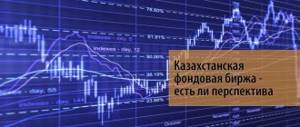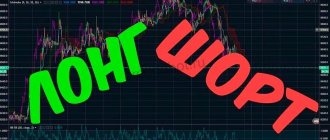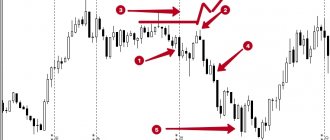Who are bulls and bears and why are they called that in financial markets? Initially, this was the name given to players who trade only on the stock exchange, then these concepts were transferred to other markets. Bears and bulls are the two most common types of traders, but in addition to them there is also a whole brood of different animals: sheep, hares, moose, lemmings, pigs and wolves. This is how various players are called in traders’ language (slang) for their trading style and behavior on the stock exchange.
Who are the bulls
Bulls on the stock exchange are investors and traders who open transactions to increase the price of any asset - a security, currency, derivative, etc.
Such a player does not work with short transactions. He enters long positions, hoping to make money on a significant increase in value. The main goal of stock market bulls is to find the moment when the quote reaches its bottom and is ready for a long upward movement. Buying an asset at this point provides players with a significant profit.
How do bulls make money on the stock market?
Bulls buy shares in the hope that their value will rise. They wait for the prices of the purchased securities to peak, after which they sell them. The resulting difference is the earnings of these traders. The fury with which they drive up the price of shares is compared by stock market players to the way a bull lifts its victim on its horns and tosses it to the ground.
Bull on Wall Street. Photo: www.globallookpress.com
Who are bears
Bears are traders who short the market - open short positions and make money on a fall in the value of an asset. For this reason, the global downward movement is called a bearish trend.
It is believed that bears are less patient than bulls. They don't like to hold a deal for long. This is supported by the fact that to open a short position it is necessary to borrow assets. And if the position is open for a long time, then the bears have to pay a significant commission.
Can a bull become a bear?
No one forbids moving from one status to another. There are traders who stick to one course all their lives. But lately there are fewer and fewer of them. Changing preferences depending on market conditions is much more profitable and therefore much more convenient.
Not everyone succeeds in concluding deals in close proximity to price lows and highs. Traders are adventurous by nature, so they tend to experiment and sometimes change their “game” strategy. Moreover, being in, say, “bear” status for a long period of time when the market is rapidly going up is simply pointless.
Bulls and bears - what's the difference?
These categories of players are key figures on the exchange. The same investor can periodically become a bull or a bear.
Bulls
They buy undervalued assets with clear growth potential. Such high volume positions create a bullish movement. When buying a stock or currency that is moving in an uptrend, players try to sell these assets as close as possible to the reversal point of the chart. This is how they get maximum profit.
The Bears
These stock market characters wait for the moment when the market is overbought - when the price rises too much and too quickly. After such growth, the value of the asset will inevitably begin to go down. Favorable times for bearish trades are times of bad news, economic turmoil and crises. During such periods, assets lose a lot of value, and in a short time.
Bears buy stocks on margin (on debt) when they peak in value. And then they immediately sell the purchased instrument at the market price. When the stock price reaches its minimum value, traders close the trade. That is, they buy back shares from the market, pay off previously taken out debt, and keep a cash profit (the difference in price between sale and purchase).
Sometimes the time for repayment of such a loan may be limited to one trading day. There are also cases where a short trade is held for several months or even years. An example of a long bearish period is the fall in oil prices in 2015-2016.
Way to make money for bears
It is not profitable for bears for the price of shares on the stock exchange to increase. That is why they look for securities that, in their opinion, will definitely not increase in price.
Among the criteria that attract the attention of “clubfooted” people are:
- poor company reporting;
- the recent dismissal of the CEO;
- industrial accidents and incidents.
In fact, they are attracted by all factors that could hypothetically have a negative impact on the value of securities.
The earning scheme could be as follows: the bear borrows a thousand shares of the company and immediately begins to get rid of them, selling, for example, one dollar at a time. During the deal, he manages to make a profit of a thousand dollars. Further (if his forecasts turn out to be correct), the securities begin to fall in price on the stock exchange.
During the trading session, he buys back previously sold shares, but not for one dollar, but, say, for fifty cents. Having bought everything, he returns them to the owner, while retaining a profit of $500.
The history of the emergence of terms and the war between them
The first term is associated with the image of a bull attacking its opponent and lifting him up on its horns. Bear traders were called bears by analogy with a bearish attack. The animal attacks the victim, hits it with its paw from top to bottom and presses it to the ground.
These visual images reflect the strategy of players who are buying assets, or vice versa - pushing the price towards the bottom.
The confrontation between bulls and bears comes down to the following:
- Bulls strive to raise the price of an asset in order to sell it profitably at the highest possible point. They are trying to create excitement and convince smaller market participants to join the upward movement.
- Bears are trying to reduce the price. Large players, by opening short positions at a favorable price, can create a powerful selling impulse, convincing other market participants that the instrument will go down. If a large number of small players believe the bears, they will open sell orders and strengthen the bearish trend.
If you study the market over large periods, you will notice both bullish and bearish trends. But on a global scale, upward trends collectively exceed downward ones. The reason for this is the natural growth of the economy and technological progress.
At the same time, there is a pattern that a bull market grows gradually, while a bear market is characterized by sharp falls.
How bulls work
Bulls in stock trading are traders who buy securities and expect their value to increase in the future. Their main goal is to buy an asset at a low price and then sell it at a high price. They look for undervalued assets that may grow in the future and acquire them in order to then sell them at a profit. Such operations are called “opening a long position.”
When the value of assets rises, the trade is closed by the bulls and the assets are sold. The difference between the minimum and maximum exchange rate values is the earnings of such traders. Bulls prefer to purchase assets at the peak of falling prices and patiently wait for price growth. Their element is the market at a time of growth; during a market decline, they wait for the price of assets to drop to the level they need to enter the market.
The state of the market is associated with the main players. In a bull market, the economy grows, unemployment decreases, GDP increases, and stock prices rise. It is much easier for bulls to choose assets for investment, since almost all assets are rising in price. We just need to remember that growth cannot continue forever and someday there will be a decline. Bulls should be careful, as the market may become oversaturated and securities will be overvalued. In this case, the market will inevitably fall. It is necessary to be able to exit a bull market in time.
Causes of bear and bull markets
Large market participants can influence price movements. But a bearish trend (a price decline of 20% or more) is in most cases due to economic problems:
- decrease in income of the population;
- unemployment;
- falling profits of large companies, etc.
A market is called bullish when the growth in asset values is more than 20%. There are several main reasons for this price movement:
- GDP growth;
- reduction in unemployment;
- growth in profits of large enterprises;
- increasing the level of investor confidence.
It is worth considering that regardless of the general direction of the market, an individual stock can go into a bullish or bearish movement. The reason for this may be the rapid development of the issuing company or a strong decrease in investor confidence.
Price formation and trade transactions
The formation of the price of an asset in financial markets depends primarily on the balance of supply and demand. For example, if the price of an asset increases, demand for it inevitably decreases. As a result, the number of sellers in the market increases and the number of buyers decreases. The opposite effect causes an increase in the volume of the asset on the market, after which the price returns to its original state.
The situation with the formation of the price per share is completely different. The determining factor here is the psychological attitude and expectations of experienced traders. The “real price” of certain securities often differs significantly from the market equivalent.
Advice from Sravni.ru:
Do you want to try your hand at trading? Carefully study the main strategies and choose yours.
Bulls and bears on Wall Street and other markets
Many major exchanges have statues outside their offices depicting the two main types of players and trends.
The most famous bull figure is on Wall Street near the New York Stock Exchange. The hero is depicted filled with rage and ready to attack. The weight of the statue is 32,000 kg.
A bear and a bull looking at each other unkindly can be seen near the Frankfurt Stock Exchange.
Shanghai also has its own charging bull. It was created by the same architect who worked on the statue installed in New York.
There is another symbol of upward market movement near the Bombay Stock Exchange.
An aggressive bull was also installed at the Amsterdam stock exchange, ready to raise the enemy's horns.
Since an uptrend is inherently considered positive, bringing profit to all market participants, bull statues can be seen more often.
What are bullish and bearish trends in the market?
You cannot always be only a bear or only a bull in the market. For example, in 2021 the Moscow Exchange index grew by leaps and bounds, and almost all Russian investors were bulls. After all, it was profitable. There was a real bullish trend in the market. This means that almost everything is growing, developing and becoming more expensive.
But then March 2021 and the pandemic arrived. And many bulls became bears. After all, the shares were falling, and everyone wanted to sell them at a higher price and then buy them back at a lower price.
Now the situation on the stock exchange is unpredictable, and right now it is clearly visible who is a pessimist at heart and who is an optimist. Optimistic bulls began to buy shares that had fallen in price, hoping that by the end of the year or, at most, by the middle of the next, they would be able to make money on them. And pessimistic bears are waiting for a second wave of the pandemic and another fall.
Other characters of the exchange
In addition to bulls and bears, you can see other models of player behavior in the market.
These include the following:
- Sharks. Wealthy individual investors. They can have a significant impact on the quotes of an individual instrument.
- Whales. These are large players who own large amounts of assets. By opening positions for huge amounts, they can shift the quotes of an entire market. Whales are often banks, corporations, and investment funds.
- Wolves. Experienced professionals who know how to work with the market. However, they do not necessarily manage large capitals.
- Moose. From English loss - loss. Traders who constantly suffer losses. Catching a moose means closing a deal at a loss.
- Sheep. Cautious market participants who are afraid of losing money. They make the decision to sell or buy later than others, and often miss opportunities.
- Hamsters. Beginners who do not yet know how to recognize key trends, but trade with extreme confidence. In the image of a hamster, such traders thoughtlessly accumulate assets “by both cheeks” and do not know what to do with them next.
- Lemmings. Beginners who focus on famous traders. They rarely make decisions on their own.
- Pigs. Greedy traders who hold a position for as long as possible in order to get maximum profit. The moment when a trend changes is often missed.
- Hares. Players who make money on minor exchange rate fluctuations. They buy and sell an instrument within one trading session.
It is rare for a market participant to adhere to one model of behavior. As you master the basic principles of successful investing and study different strategies, the trader's trading style periodically changes.
Previous article. What is Forex
Next article. Combining work and trading
What does it mean to "catch a moose"
Anyone participating in trading in the stock market runs the risk of catching a moose. In stock exchange slang, this means “receiving a loss, losing money.” The concept of “moose” comes from a consonance with the English word “loss”, which in translation means damage, loss, so this situation is not a pleasant one. Moose is a relative concept and can be either large or small depending on the amount of money lost.
To ensure that the moose does not become large, a special stop order is used, which automatically closes unprofitable positions when the price reaches a certain level. Such an order is called “stop-loss”, translated as “stopping losses, limiting losses”. In addition, a trader who suffers serious losses is called a moose.
Indicator of the strength of bears and bulls – Balance of Power
Along with the indicators described, there is such a tool as Balance of Power, i.e. balance power. It combines both algorithms, and differs from them in that it is calculated based on price highs and lows using the formula:
(Closing price – Opening price)/(Maximum – Minimum).
The indicator also belongs to oscillators. Moreover, it is visually presented in the form of red and blue histograms. The candles are also painted in similar colors. The signals from this tool are simple:
- large blue bars – a growing trend, you can buy;
- red bars of blue sizes – a falling trend, you can sell.
You can also open trades at the moment when the bars cross the center line. If they move up, it is a buy signal, and if they move down, it is a sell signal. Stop loss and take profit levels are set according to the rules of a specific strategy. In most trading systems it is mandatory to use them.
Other animals on the market
Since the securities market has accepted the “animal” names of the main players, like bull and bear, then why not go further? Other, less important market participants also acquired their own names; in the best traditions of the exchange, they were also animal names. Not all of them correctly understand what investments and the market are, which leaves an imprint on their behavior in trading.
These names are based primarily on the level and quality of traders' trading and are used to evaluate completed transactions. Thus, for example, wolves are distinguished: these are traders whose transactions are almost one hundred percent profitable. Moose always suffer losses, that is, they close it in the red. The market calls lemmings newcomers whose trading is aimed at professional traders.
Hares
Particular attention should be paid to the so-called hares. These are exchange players who play on unstable exchange rate fluctuations. Such players in the securities market are capable of closing a huge number of transactions in one trading session. They are named so because any change in the exchange rate most often frightens them and causes a panicky desire to get rid of assets. The market does not always bring profit to hares - this style of trading is often unprofitable.
Sheep
Sheep are the most cautious traders on the stock exchange. Owning assets, they cannot decide on their tactics and often take no action. And when they decide, they suffer losses, because as popular wisdom says, a submissive sheep is milked three times.
Pigs
Pigs are those exchange participants who, despite the general trends of the exchange, tend to hold their positions for quite a long time. For such traders, profit is an end in itself: they do not think where, when, how much and what they invest in. Pigs only care about positive results. For the most part, pigs are players with fairly large assets and solid positions. And, as often happens, the irresponsibility of pigs leads to serious financial losses.
It is impossible to beat the financial market without trading on it.
In this article, we looked at all exchange participants, paying more attention to bull and bear types and their trading styles on the exchange. Each trader trades differently: even experienced players are not always able to guess the market mood at the current moment. Some simply do not understand the principles of how the market works, while others know the basics of investing. But he does not know how to apply them in practice. Not every new investor is able to quickly understand all the intricacies of a huge financial colossus, but, as the popular quote says, those who don’t take risks don’t drink champagne.
Author Ganesa K.
A professional investor with 5 years of experience working with various financial instruments, runs his own blog and advises investors. Own effective methods and information support for investments.
Let's summarize
A bull market is an economically sound market that is on the rise, while a bear market is a falling market in which assets lose value. Although some famous investors can be called classic bears (eg: David Rosenberg, Jim Rogers, Mark Faber), most investors are bulls. If you look at all the statistics for all time, you can see that the stock market has always demonstrated profitability.
Bearish trends are more dangerous for investments as many stocks lose value. This narrows the market, which ultimately hurts the bears themselves. Reaching a market bottom is difficult because most investors start withdrawing money and hold it until the trend reverses, only making the situation worse.
And whoever suffers losses in any case are pigs. Pigs always lose. “Bulls make money, bears make money, and pigs get slaughtered,” says an old saying that warns against being too greedy and impatient. And this wisdom is worth listening to.











